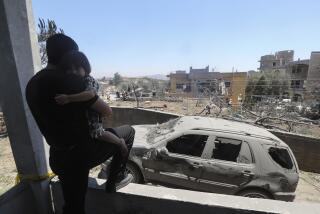The sky’s not the limit in new U.S. war
- Share via
Miles above the Earth, inside the slender fuselage of a Boeing 707, the crew of a stunningly complex flying command center concentrates on more than a dozen brightly colored video screens.
They are the new masters of war, and their plane is a key component in an armada that includes satellite-guided missiles, unmanned reconnaissance aircraft, computer-packing ground troops and an assortment of field artillery.
As the mission in Afghanistan moves beyond the initial air assault, the E-8C Joint Surveillance Target Attack Radar System, or STARS, command plane likely will play a key role in a campaign that is using sophisticated communications equipment and powerful computers to ferret out an elusive foe.
The world got a first peek at high-tech warfare during the Persian Gulf War a decade ago. But as anyone who owns a personal computer knows, processing power and communications speeds have made quantum leaps since then. The military’s equipment has advanced in tandem.
“The military has benefited greatly from the information revolution of the past decade, and it is able to use that technology in combat,” said John Pike, co-founder and defense analyst with the GlobalSecurity.org think tank.
Instantaneous strikes
A decade ago, it could take hours or even days to destroy a target after it was located. In Afghanistan, the goal is 10 minutes.To accomplish that, the military operates an elaborate communications network that allows troops, high-altitude spy planes, sky-scanning AWACS, Joint STARS planes and a vast assortment of other equipment to communicate.
“We have systems that can be put into play on all levels of the conflict,” said Daryl Davidson, executive director of the Association for Unmanned Vehicle Systems International, an industry group.
What the melange of airborne systems gathers is forwarded to mobile ground stations, which in turn can relay data to soldiers equipped with computers and electronic information-gathering equipment. If the system works as designed, the entire terrain and the air above are completely monitored.
The Global Positioning System, or GPS, is the linchpin of much of the new communications technology. Satellites orbiting the planet give guided missiles, unmanned drone planes, jet fighters, bombers and ground troops an exact fix on their locations. Land-based and flying command centers collect their data and positions, and use the input for plotting strikes.
“The satellites are absolutely key,” said Christopher Hellman, senior analyst for the Center of Defense Information in Washington.
STARS of the new fleet
One of the newer pieces of the airborne arsenal is the Joint STARS equipment, which uses an electronics system from Northrop Grumman Corp. in Melbourne. Eleven of the planes -- which cost about $260 million each -- are in operation, and government funding is available for five more. This week, Northrop received an additional $67 million contract as part of the Joint STARS program.The planes haven’t been deployed yet, but military analysts say they are critical. Each is capable of monitoring hundreds, if not thousands, of targets on the ground.
“With Joint STAR, there is a tremendous amount of information available to troops on the ground, all in real time,” Northrop Grumman spokesman John Vosilla said. “In previous wars, the Army would send somebody to a hilltop to look around and send information back. With Joint STAR, the information is gathered and forwarded instantly.”
Two Joint STARS prototypes were used in the Gulf War. Since 1996, a wing of 11 planes has been stationed at Robins Air Force Base in Georgia.
“We’re changing the way war is fought,” said Capt. John Bryan, spokesman for the 93rd Air Control Wing at Robins. “With Joint STARS, we’re capable of looking at conditions on the ground from as far away as 250 kilometers [150 miles]. That means we can do surveillance from another country in many cases.”
In Afghanistan, Joint STARS likely will work in concert with two flying platforms: Airborne Warning and Control System (AWACS) planes, which monitor the air, and Rivet Joints, which can lock on to enemy broadcasts for targeting and can scramble an opponent’s systems.
Behind enemy lines
The Air Force’s Predator, an unmanned drone about the size of a civilian Cessna, is also playing a role, probing potentially dangerous enemy airspace, gathering intelligence and sending back pictures used by manned aircraft and guided-missile launchers. On Thursday, the military revealed that Predator has been outfitted with Hellfire anti-tank rockets, a first for an unmanned aircraft.Predators in Afghanistan, controlled remotely by operators in the United States, were among the first U.S. aircraft to enter the country.
The communications web allows the military to share information over a network, giving it far greater flexibility than it had in previous wars to locate the enemy and launch a rapid attack.
“We call what we do cross-queuing,” Bryan said. “AWACS look at what’s going on in the skies; we [Joint STARS] look at what’s happening on the ground. We cross-queue with the AWACS and unmanned vehicles to build a picture and pick targets. Warfare can be very confusing, but with these systems, we can accurately track hundreds, if not thousands, of targets simultaneously.”
As the operation in Afghanistan moves into its next phase, troops also will benefit from new technology: computers, night-vision goggles and a host of other paraphernalia. Like the cross-queuing aircraft, individual soldiers gather data and transmit it to other elements on the battlefield.
In what President Bush says could be a multiyear effort to root out terrorism, the possibilities for new, high-tech weaponry are huge. But the costs of the new systems will be very high.
“The technology to do these things is years, not decades, away,” analyst Pike said. “[But] the number of things that are physically possible is different from what is economically viable.”
More to Read
Sign up for Essential California
The most important California stories and recommendations in your inbox every morning.
You may occasionally receive promotional content from the Los Angeles Times.










